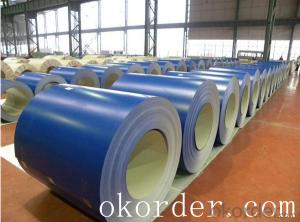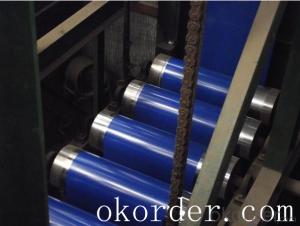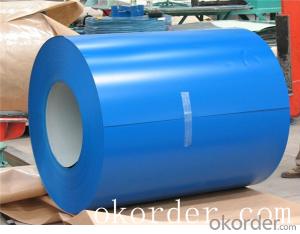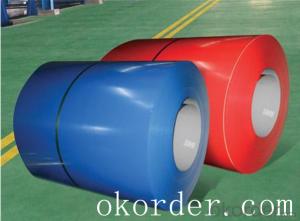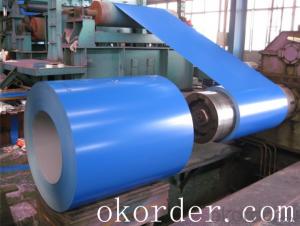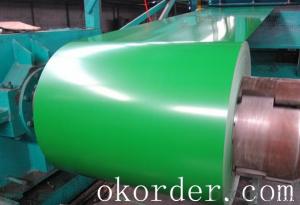Prime quality prepainted galvanized steel 630mm
- Loading Port:
- Tianjin
- Payment Terms:
- TT OR LC
- Min Order Qty:
- 100 m.t.
- Supply Capability:
- 10000 m.t./month
OKorder Service Pledge
OKorder Financial Service
You Might Also Like
Construction building material galvanized color prepainted cold
rolled steel coil
Prepainted steel sheet is coated with organic layer, which provides higher anti-corrosion property and
a longer lifespan than that of galvanized steel sheets.
The base metals for prepainted steel sheet consist of cold-rolled, HDG electro-galvanized and hot-dip
Alu-zinc coated. The finish coats of prepainted steel sheets can be classified into groups as follows:
polyester, silicon modified polyesters, polyvinylidene fluoride, high-durability polyester, etc
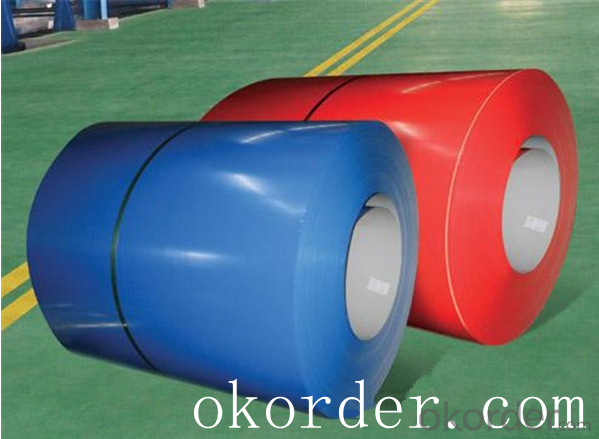
Standard and Grade :
Pre-paint galvanized steel coil | ||||
ASTM A755M-03 | EN10169:2006 | JISG 3312-2012 | ||
Commercial quality | CS | DX51D+Z | CGCC | |
Structure steel | SS GRADE 230 | S220GD+Z | CGC340 | |
SS GRADE 255 | S250GD+Z | CGC400 | ||
SS GRADE 275 | S280GD+Z | CGC440 | ||
SS GRADE 340 | S320GD+Z | CGC490 | ||
SS GRADE550 | S350GD+Z | CGC570 | ||
S550GD+Z | ||||
Application:
Outdoor | Roof, roof structure, surface sheet of balcony, frame of window, door of garage, rolled shutter door, booth, Persian blinds, cabana, etc |
Indoor | Door, isolater, frame of door, light steel structure of house, home electronic appliances, ect. |
- Q:What are the potential applications of steel billets in the aerospace industry?
- The aerospace industry can make use of steel billets in a variety of ways. One primary application is using them to produce structural components. By forging or machining steel billets, it is possible to create strong and long-lasting parts like beams, brackets, and frames. Another important use of steel billets in aerospace is for manufacturing landing gear components. These components need to endure high levels of stress and fatigue, and steel billets provide excellent strength and toughness properties that make them well-suited for this purpose. Steel billets can also be employed in the production of engine components. The aerospace industry requires materials that can withstand extreme temperatures and maintain their mechanical properties under high-stress conditions. By subjecting steel billets to heat treatment, it is possible to enhance their resistance to heat and corrosion, making them suitable for use in engine parts such as turbine blades, shafts, and casings. Furthermore, steel billets can be utilized in the construction of fuel systems and hydraulic systems. These systems often require components that can handle high pressure and resist corrosion. Steel billets can be machined into fittings, connectors, and valves that meet these requirements, ensuring the safety and reliability of these critical systems. Overall, the potential applications of steel billets in the aerospace industry are extensive and varied. From structural components to landing gear systems, engine parts, and fuel systems, steel billets offer the necessary strength, durability, and resistance properties required for the demanding conditions of aerospace operations.
- Q:What is the role of steel billets in the production of valves and fittings?
- Steel billets play a crucial role in the production of valves and fittings as they serve as the primary raw material for manufacturing these products. The billets are heated and then shaped and formed through various processes like forging, machining, and welding to create the desired valve or fitting. The high strength and durability of steel billets ensure the reliability and longevity of valves and fittings, making them essential components in industries such as oil and gas, water treatment, and manufacturing.
- Q:What is the difference between steel billets and steel bars?
- Steel billets and steel bars, two semi-finished products made from steel, exhibit distinct dissimilarities. To begin with, steel billets possess larger dimensions compared to steel bars. Billets typically assume a square or rectangular form with a cross-sectional area ranging from 36 to 216 square inches. Their production commonly involves the continuous casting process, which entails pouring molten steel into molds, followed by cooling and solidification. Billets function as the initial material for various steel products, including bars, rods, and wire. Conversely, steel bars display smaller proportions and adhere to more standardized shapes. Their configuration can be round, square, hexagonal, or flat, contingent upon their intended application. The production of steel bars chiefly involves the hot rolling method, wherein billets undergo heating and are subsequently passed through a series of rolling mills to achieve the desired dimensions and shape. Bars frequently find use in construction, manufacturing, and other industries that prioritize strength and durability. Another disparity between steel billets and steel bars resides in their surface finish. The casting process renders steel billets with a rough mill-scale surface. In contrast, steel bars possess a smoother surface finish, achieved through hot rolling and subsequent finishing procedures such as peeling, grinding, or polishing. Moreover, steel billets primarily serve as raw materials for further processing, while steel bars represent the final product that can be directly employed in diverse applications. Steel bars commonly feature in construction projects as reinforcement for concrete structures, in machinery and tool production, as well as in the manufacturing of automotive parts, among numerous other industrial applications. In conclusion, steel billets and steel bars differ in terms of size, shape, surface finish, and purpose. Billets are larger, rougher, and act as the starting point for various steel products, whereas bars are smaller, boast a smoother surface finish, and emerge as the final product utilized across a wide array of applications.
- Q:What are the different surface defects found in alloy steel billets?
- Alloy steel billets can exhibit several surface defects that may arise during production, impacting the final product's quality and performance. Some typical defects seen in these billets are as follows: 1. Scale: Scale refers to a thin layer of oxide forming on the billet's surface during heating and cooling. It can occur due to exposure to air or the presence of impurities in the steel. Scale can have adverse effects on the surface finish and lead to corrosion. 2. Cracks: The billet's surface may develop cracks due to various factors, such as improper cooling, excessive stress, or mishandling. These cracks can compromise the billet's structural integrity, potentially resulting in failure during subsequent processing or in the final product. 3. Pits: Pits are small depressions or cavities found on the billet's surface. They can arise from impurities or the steel's reaction with the environment. Pits can impact the surface finish and serve as stress concentration points, leading to further damage or failure. 4. Laminations: Laminations refer to layers or sheets of non-metallic material within the billet. They can occur due to incomplete bonding during production or the presence of impurities in the steel. Laminations can weaken the billet, making it susceptible to failure under load. 5. Inclusions: Inclusions are non-metallic particles or impurities present in the steel. They may be introduced during production or already present in the raw materials. Inclusions can affect the steel's mechanical properties, reducing its strength, toughness, and ductility. 6. Decarburization: Decarburization involves the loss of carbon from the steel's surface. It can happen during the heating process or due to exposure to air. Decarburization can lead to reduced hardness and strength in the affected area. Detecting and addressing these surface defects in alloy steel billets is crucial for ensuring the production of high-quality and reliable products. Various inspection and testing methods, including visual inspection, ultrasonic testing, and magnetic particle inspection, can be employed to identify and assess these defects.
- Q:Are steel billets used in the shipbuilding industry?
- Yes, steel billets are commonly used in the shipbuilding industry. Steel billets are semi-finished steel products that are further processed into various shapes and sizes to construct different components of a ship's structure, such as hulls, decks, and bulkheads. These billets provide the necessary strength and durability required for the construction of ships, making them an essential material in the shipbuilding process.
- Q:What are the main factors affecting the dimensional accuracy of steel billets?
- There are several main factors that can affect the dimensional accuracy of steel billets. Firstly, the temperature during the casting process plays a crucial role. Steel billets are typically cast at high temperatures, and any fluctuations or inconsistencies in the temperature can lead to dimensional inaccuracies. If the temperature is too high, the billet may expand and result in larger dimensions than desired. Conversely, if the temperature is too low, the billet may contract, leading to smaller dimensions than intended. Therefore, maintaining a consistent and controlled temperature is essential for achieving dimensional accuracy. Secondly, the cooling process after casting can also impact the dimensional accuracy of steel billets. Rapid cooling can cause the billet to contract unevenly, leading to distortions in its dimensions. On the other hand, slow cooling can result in excessive growth and expansion of the billet. Therefore, the cooling rate needs to be carefully controlled and optimized to ensure uniform and accurate dimensions. Thirdly, the design and condition of the casting molds can significantly influence the dimensional accuracy of steel billets. The mold should be properly designed to allow for shrinkage and compensate for any potential distortions. Additionally, the condition of the mold, such as wear and tear or improper alignment, can also lead to dimensional inaccuracies. Regular maintenance and inspection of the molds are necessary to ensure their proper functioning and minimize any potential impact on dimensional accuracy. Lastly, the composition and quality of the steel itself can affect the dimensional accuracy of the billets. Variations in the chemical composition or impurities in the steel can lead to inconsistencies in the cooling and solidification process, resulting in dimensional inaccuracies. Therefore, stringent quality control measures and precise composition monitoring are essential to minimize any variations in the steel and maintain dimensional accuracy. In conclusion, the main factors affecting the dimensional accuracy of steel billets include temperature control during casting, the cooling process, the design and condition of the casting molds, and the composition and quality of the steel. By closely monitoring and controlling these factors, manufacturers can ensure the production of steel billets with accurate dimensions.
- Q:Are steel billets recyclable?
- Yes, steel billets are recyclable. Steel is one of the most recycled materials in the world, and the process of recycling steel billets is well-established and highly efficient. When steel billets reach the end of their useful life, they can be melted down and reused to produce new steel products. This recycling process helps to conserve natural resources, reduce energy consumption, and minimize environmental impact. Additionally, recycling steel billets also helps to reduce the amount of waste sent to landfills and contributes to the circular economy by promoting the sustainable use of resources.
- Q:How are steel billets used in the manufacturing of automotive engine components?
- Steel billets are an essential raw material used in the manufacturing of automotive engine components. These billets are semi-finished steel products that are cast into specific shapes and sizes. They serve as the building blocks for various engine parts, such as crankshafts, connecting rods, camshafts, and cylinder blocks. Steel billets undergo a series of processes to transform them into engine components. The first step involves heating the billets to a high temperature, making them malleable and ready for forging or machining. Forging is a common method used to shape the billets into desired forms. It involves applying pressure and force to the heated billet to mold it into the required shape, such as the curved shape of a crankshaft. Once the billets have been forged into the desired shape, they undergo further machining processes to refine their dimensions and achieve the desired level of accuracy. This includes drilling, milling, turning, and grinding, which are performed using specialized machinery and tools. Machining ensures that the engine components meet the strict tolerances required for optimal performance and reliability. Steel billets are chosen for their exceptional strength, durability, and heat resistance properties. These characteristics are vital for engine components, as they are subjected to high pressures, temperatures, and loads during operation. Steel's high tensile strength and ability to withstand extreme conditions make it an ideal material for these critical parts. In summary, steel billets play a crucial role in the manufacturing of automotive engine components. Through forging and machining processes, they are transformed into highly precise and durable parts that contribute to the smooth and efficient operation of an engine. The use of steel billets ensures the overall quality and performance of automotive engines, making them an integral part of the manufacturing process.
- Q:What are the different surface finishes available for stainless steel billets?
- Stainless steel billets offer a range of surface finishes to meet diverse aesthetic and functional needs. Here are some commonly used finishes: 1. The mill finish is the standard produced by the steel mill during manufacturing. It presents a dull appearance with visible oxidation marks, and its smoothness may vary. 2. Hot rolling involves heating the billet and rolling it through rollers to achieve a rougher surface with visible scale and an orange peel texture. 3. Cold rolling reduces the thickness of the billet and enhances surface smoothness, resulting in a slightly reflective finish suitable for applications requiring smooth surfaces. 4. The brushed finish, also known as satin finish, entails mechanically brushing the billet with abrasive materials to create a consistent linear pattern and a matte appearance. 5. Polishing the billet with abrasives produces a smooth and reflective surface, with varying levels of gloss, ranging from low-gloss satin to mirror-like high reflectivity. 6. Bead blasting involves bombarding the billet with tiny glass or ceramic beads at high pressure to create a uniform matte texture, often used for architectural and decorative purposes. 7. Electropolishing achieves a smooth and reflective surface with enhanced corrosion resistance by immersing the billet in an electrolyte bath and applying an electric current to remove a thin layer of material. These examples illustrate the variety of surface finishes available for stainless steel billets. Each finish possesses unique characteristics and is selected based on specific requirements, such as aesthetics, corrosion resistance, and ease of cleaning.
- Q:How are steel billets used in the production of reinforcement bars?
- Rebar production relies heavily on steel billets, which are integral components. These billets, resembling rectangular or square semi-finished steel products, act as the initial stage in the manufacturing process. To create rebar, the steel billets are first heated to a temperature surpassing their recrystallization point in a furnace. This procedure, known as hot rolling, involves passing the heated billets through a series of rollers. These rollers gradually decrease the billets' cross-sectional area while elongating the material. Consequently, the billets transform into long, slender bars possessing the desired mechanical properties and dimensions. Throughout the hot rolling process, the steel billets experience significant plastic deformation. This deformation leads to the realignment of grains within the material, resulting in a more uniform and compact structure. This refined microstructure enhances the strength and durability of the rebar, thereby making it ideal for construction projects necessitating high tensile strength, such as reinforced concrete structures. The size and shape of the steel billets employed in rebar production vary according to specific end-product requirements. It is crucial to note that the quality of the billets plays a vital role in determining the rebar's overall quality. Therefore, manufacturers must meticulously select and inspect the billets to ensure they meet the required specifications and standards. In conclusion, steel billets are indispensable in rebar production as they undergo transformation through the hot rolling process, resulting in the desired shape and dimensions. The resulting rebar exhibits enhanced strength and durability, rendering it suitable for reinforcing concrete structures and ensuring their structural integrity.
1. Manufacturer Overview |
|
|---|---|
| Location | |
| Year Established | |
| Annual Output Value | |
| Main Markets | |
| Company Certifications | |
2. Manufacturer Certificates |
|
|---|---|
| a) Certification Name | |
| Range | |
| Reference | |
| Validity Period | |
3. Manufacturer Capability |
|
|---|---|
| a)Trade Capacity | |
| Nearest Port | |
| Export Percentage | |
| No.of Employees in Trade Department | |
| Language Spoken: | |
| b)Factory Information | |
| Factory Size: | |
| No. of Production Lines | |
| Contract Manufacturing | |
| Product Price Range | |
Send your message to us
Prime quality prepainted galvanized steel 630mm
- Loading Port:
- Tianjin
- Payment Terms:
- TT OR LC
- Min Order Qty:
- 100 m.t.
- Supply Capability:
- 10000 m.t./month
OKorder Service Pledge
OKorder Financial Service
Similar products
New products
Hot products
Hot Searches
Related keywords
